You are using an out of date browser. It may not display this or other websites correctly.
You should upgrade or use an alternative browser.
You should upgrade or use an alternative browser.
chronically low vacuum indication
- Thread starter GeorgeC
- Start date
Dan Thomas
Touchdown! Greaser!
- Joined
- Jun 16, 2008
- Messages
- 10,777
- Display Name
Display name:
Dan Thomas
Which is why I have sometimes seen NPT non-O-ring fittings with a short length of aluminum tubing on them, and the hose clamped to the tubing.I spent far too much time last night looking for o-ring NPT fittings, with hose barbs, in aluminum. Unobtainium, it seems.
There are no NPT O-ring type fittings. The O-ring fittings use a straight non-tapered thread. NPT means National Pipe Taper.
What you need are these:
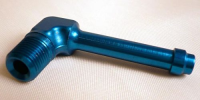
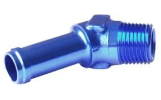
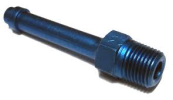
All from https://www.wicksaircraft.com/c/aircraft-automotive-fittings/aircraft-fittings/an-ms-fittings/
Aircraft Spruce would also have them. Various sizes. Stupidly expensive.
Clamps.Are clamps required on suction hoses? If so, can zipties be substituted?
- Joined
- Dec 5, 2010
- Messages
- 5,157
- Display Name
Display name:
GeorgeC
I only saw one hose because there was only one hose hooked up. I pulled the gauge off and one of the ports had some kind of horrible jb weld repair done to it. The other port was just missing entirely. Sigh.I only saw one hose going to the gauge.
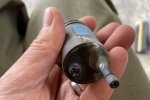
You are correct. Also, barbed nylon connectors are awful.You do not want to pull existing hose off. Cut it instead.
Last edited:
- Joined
- Dec 5, 2010
- Messages
- 5,157
- Display Name
Display name:
GeorgeC
So that others do not repeat my mistake:
"[Nylo-Seal] N Tubing is rated to 1000 lbs. and is excellent for instrument lines and other low pressure applications."
Sounds great. But wait, there's more! The NSR flavor tubing has an smaller bend radius, so it must be even better! And it's cheaper than aeroquip! Quick, buy some!
...except that it's 3/8 OD, not 3/8 ID, and it's much more rigid than aeroquip.
Womp womp.
"[Nylo-Seal] N Tubing is rated to 1000 lbs. and is excellent for instrument lines and other low pressure applications."
Sounds great. But wait, there's more! The NSR flavor tubing has an smaller bend radius, so it must be even better! And it's cheaper than aeroquip! Quick, buy some!
...except that it's 3/8 OD, not 3/8 ID, and it's much more rigid than aeroquip.
Womp womp.
- Joined
- Dec 5, 2010
- Messages
- 5,157
- Display Name
Display name:
GeorgeC
I replumbed the path from the left venturi-AI-filter today, being careful to check the yoke for interference.Got to watch that the controls don't foul the hoses, and with straight fittings the hoses might be in the way. They can snag the controls and make the flight way too exciting.
The funny thing? The yoke banged into the original nylon elbows on the DG. I guess those will be coming out for now...
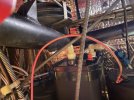
Next week, suction gauge.
Last edited:
Dan Thomas
Touchdown! Greaser!
- Joined
- Jun 16, 2008
- Messages
- 10,777
- Display Name
Display name:
Dan Thomas
I wonder if the elevator control system is properly rigged. That can bring the yoke up against instruments like that. How far away from the firewall does it stop when pushed full forward?The funny thing? The yoke banged into the original nylon elbows on the DG. I guess those will be coming out for now...
- Joined
- Dec 5, 2010
- Messages
- 5,157
- Display Name
Display name:
GeorgeC
I didn't bring a measuring tape, but it looked like a couple inches.How far away from the firewall does it stop when pushed full forward?
New gauge is in + gutted the plumbing to the right venturi. Should be able to replumb the rest next week and get it signed off.
- Joined
- Dec 5, 2010
- Messages
- 5,157
- Display Name
Display name:
GeorgeC
The winning combination for the DG was 45 degree fittings. They had to be pointed at 4-5 o'clock to not interfere with the yoke, which is about the least convenient direction. I routed the hose so that its natural tension tended to tighten rather than loosen the fitting. I also got a proper tee to hook the gauge up to the AI's inlet port. Interestingly, the AI has a low vac flag, but the DG does not.
Dan Thomas
Touchdown! Greaser!
- Joined
- Jun 16, 2008
- Messages
- 10,777
- Display Name
Display name:
Dan Thomas
Might be a good idea to get the elevator rigging checked. If it's a couple of inches away from the firewall, it's likely getting too close to the instruments. Cessna's manuals have stuff on it. The 100-Series 1962 and prior is as much info as you're likely to find, and it starts with the 150. Section 8 has the elevator rigging and cable tension stuff on page 8-6. It mentions firewall and instrument clearance.
http://www.aeroelectric.com/Referen...na_100_Series_1962_and_prior_MM_D138-1-13.pdf
The 140's elevator travel differs from the 150's; it's up 20° and down 20°, as per the TCDS, here: https://drs.faa.gov/browse/excelExternalWindow/2D3C513E9CE4433886257ED2006FB509.0001
I used to set them so that with the cables properly tensioned, I could get contact with the firewall, and maybe the panel or instruments if I pulled or pushed firmly. That assures that you are getting full control surface travel. Air loads in flight will reduce the travel due to cable stretch, and if the instrument is in the way, you're short of up-elevator, sometimes making a decent three-point landing difficult. Banging into the firewall too soon can make stall recovery sketchy. Lots of misrigged airplanes out there.
http://www.aeroelectric.com/Referen...na_100_Series_1962_and_prior_MM_D138-1-13.pdf
The 140's elevator travel differs from the 150's; it's up 20° and down 20°, as per the TCDS, here: https://drs.faa.gov/browse/excelExternalWindow/2D3C513E9CE4433886257ED2006FB509.0001
I used to set them so that with the cables properly tensioned, I could get contact with the firewall, and maybe the panel or instruments if I pulled or pushed firmly. That assures that you are getting full control surface travel. Air loads in flight will reduce the travel due to cable stretch, and if the instrument is in the way, you're short of up-elevator, sometimes making a decent three-point landing difficult. Banging into the firewall too soon can make stall recovery sketchy. Lots of misrigged airplanes out there.
